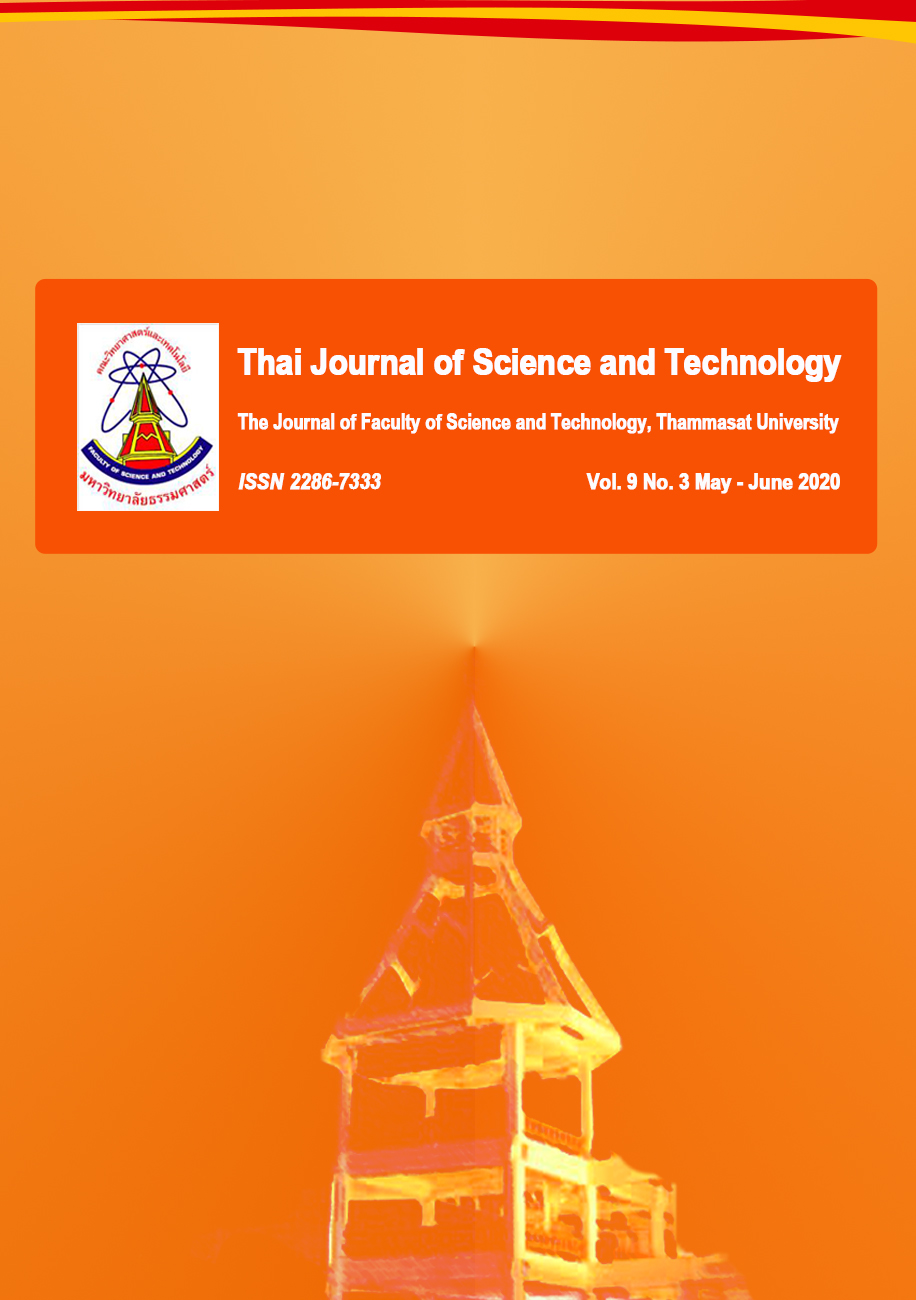คุณค่าทางโภชนะของกากนมถั่วเหลืองหมักโดย Aspergillus niger เพื่อใช้เป็นอาหารสัตว์
Main Article Content
Abstract
Soymilk residue is a by-product from soymilk production and dried soymilk residue is a source of protein, energy and fiber. Improving its nutritional value would make it more suitable for use as feed stuff. Therefore, the objective of this study was to investigate the nutritional value and dry matter digestibility in rumen in vitro of fermented soymilk residue by Aspergillus niger TISTR3013 (FSR) for 3, 5 and 7 days. The results showed that crude protein was most increased (33.48 %DM) whereas dry matter, organic matter, NDF, ADF and gross energy were decreased for 7-day FSR when compared to those of 3-day FSR and 5-day FSR. Furthermore, dry matter digestibility in rumen was highest (81.08 %) for 7-day FSR and lowest for the non-fermented soymilk residue (56.23 %). The results from these experiments showed that fermentation of soymilk residue with A. niger TISTR3013 increased protein, decreased NDF, ADF and increased dry matter digestibility in rumen.
Article Details
บทความที่ได้รับการตีพิมพ์เป็นลิขสิทธิ์ของคณะวิทยาศาสตร์และเทคโนโลยี มหาวิทยาลัยธรรมศาสตร์ ข้อความที่ปรากฏในแต่ละเรื่องของวารสารเล่มนี้เป็นเพียงความเห็นส่วนตัวของผู้เขียน ไม่มีความเกี่ยวข้องกับคณะวิทยาศาสตร์และเทคโนโลยี หรือคณาจารย์ท่านอื่นในมหาวิทยาลัยธรรมศาสตร์ ผู้เขียนต้องยืนยันว่าความรับผิดชอบต่อทุกข้อความที่นำเสนอไว้ในบทความของตน หากมีข้อผิดพลาดหรือความไม่ถูกต้องใด ๆ
References
ยุพร พืชกมุทร, 2550, การใช้ประโยชน์จากกากถั่วเหลือง, ว.พระจอมเกล้าลาดกระบัง 15(2): 34-41.
สุภัตรา โอกระโทก, 2556, ผลของการใช้กากมันสำปะหลังหมักด้วยเชื้อรา Aspergillus oryzae เพื่อเป็นอาหารในไก่ไข่, วิทยานิพนธ์ปริญญาโท, มหาวิทยาลัยเทคโนโลยีสุรนารี, นครราชสีมา.
อุษณีย์ภรณ์ สร้อยเพ็ชร์, 2550, ผลของการใช้กากมันสำปะหลังหมักโปรตีนสูงและเอนไซม์ไฟเตทจากเชื้อรา Aspergillus niger ในสูตรอาหารเป็ดเนื้อ, วิทยานิพนธ์ปริญญาโท, มหาวิทยาลัยข่อนแก่น, ขอนแก่น.
Akula, S. and Golla, N., 2018, Optimization of cellulase production by Aspergillus niger isolated from forest soil, Open Biotechnol. J. 12: 256-269.
AOAC, 1990, Official Method of Analysis, 15th Ed., Association of Official Analytical Chemists, Arlington, V.A.
Belewu, M.A. and Babalola, F.T., 2009, Nutrient enrichment of waste agricultural residues after solid state fermentation using Rhizopus oligosporus, J. Appl. Biosci. 13: 695-699.
Chen, L., Madl, R.L. and Vadlani, P.V., 2013, Nutritional enhancement of soy meal via Aspergillus oryzae solid-state fermentation, Cereal Chem. 90: 529-534.
Goering, H.K. and van Soest, P.J., 1970, Forage Fiber Analysis (Apparatus, Reagents, Procedures and Some Applications), U.S. Government Printing Office, Washington D.C., 24 p.
Hamdy, H.S., 2013, Production of mini food by Aspergillus niger, Rhizopus oryzae and Saccharomyces cerevisiae using orange peels, Roman. Biotechnol. Lett. 18: 7929-7946.
Jia, X., 1999, Decomposition effect of yeast on phytic acid in okara, Shanxi Food Ind. 4: 33-35.
Lawal, T.E., Ademola, S.G., Owoseni, A., Atobatele, O.E. and Oriye, L.O., 2013, Use of Aspergillus niger for improving the feeding value of rice offal, Afr. J. Biotechnol. 12: 3083-3087.
Lin, S.S., Dou, W.F., Xu, H., Li, H.Z., Xu, Z.H. and Ma, Y., 2007, Optimization of medium composition for the production of alkaline β-mannanase by alkaliphilic Bacillus sp. N16-5 using response surface method logy, Appl. Microbiol. Biotechnol. 75: 1015-1022.
Mabyalwa, M.M. and Setati, M.E., 2006, Screening and identification of endomannanase-producing micro fungi from hypersaline environments, Curr. Microbiol. 52: 477-481.
Matsuo, M., 1989a, Morphological and physicochemical properties and composition of okara fermented with Rhizopus oligospo rus, J. Jpn. Soc. Nutr. Food Sci. 42: 173-178.
Matsuo, M., 1989b, Morphological, compositional and physicochemical properties of okara fermented by Aspergillus oryzae, J. Agric. Chem. Soc. Jpn. 63: 1765-1770.
Moore, J., Cheng, Z., Hao, J., Guo, G., Guo-Liu, J., Lin, C. and Yu, L., 2007, Effects of solid-state yeast treatment on the antioxidant properties and protein and fiber compositions of common hard wheat bran, J. Agric. Food Chem. 55: 10173-10182.
Mukherjee, R., Ghosh, M. and Nandi, B., 2004, Improvement of dry matter digestibility of water hyacinth by solid state fermentation using white rot fungi, Indian J. Exp. Biol. 42: 837-843.
Naing, H.T.H., Swe, K.H., Muu, K.S. and Oo, S.M., 2019, Solid state fermentation of soybean meal with Aspergillus niger for upgrading nutritive values, Int. J. Innov. Edu. Res. 7: 374-381.
Piamphon, N., Wachirapakorn, C., Pornsopin, P., Sotawong, P. and Gunun, P., 2014, Feed intake, digestibility and blood parameters as influenced by Aspergillus niger or Saccharomyces cerevisiae fermented Napier grass (Pennisetum purpureum) mixed with fresh cassva root in beef cattle, Khon Kaen Agr. J., 42: 54-60.
Qiao, J. and Zhang, F., 2008, Research on the processing of microbial protein feed by mixed culture solid-state fermentation, Feed Ind. 29(22): 21-24.
Ramesh, M.V. and Lonsane, B.K., 1990, Critical importance of moisture content of the medium in alpha-amylase production by Bacillus licheniformis M27 in solid-state fermentation system, Appl. Microbiol. Biotechnol. 3: 201-205.
Safar, O., Farhangi, M., Carter, C., Yakhchali, B., Bai, S. and Sangatash, M.M., 2012, Study on the effect of solid-state fermentation with A. niger on antinutritional factors of canola protein concentrate with aim of using in the diet of rainbow trout (Oncorhynchus mykiss), pp. 1-12, In The 1th International and the 4th National Congress on Recycling of Organic Waste in Agriculture, Isfahan.
SAS, 2004, STAT User’s Guide Release 9.1.3. SAS Inst., Inc., New York, 220 p.
Senevirathne, N.D., Anderson, J.L., Gibbons, W.R. and Clapper, J.A., 2017, Growth performance of calves fed microbially enhanced soy protein in pelleted starters, J. Dairy Sci. 100: 199-212.
Srichana, D., Suttitham, W., Thongsunthiah, P., Panja, P. and Jariyapamornkoon, N., 2014, Neutrients and ruminal digestibility of baby corn by-product silages under different harvesting medthods, Thammasat Int. J. Sci. Technol. 19(2): 30-36.


